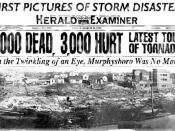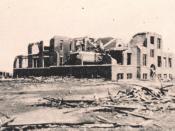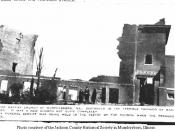Crash! A severe thunderstorm warning was issued 10 minutes ago. Hail the of size golf balls are smashing on top of your car. Do you keep going or stop and wait for that unexpected tornado to hit?
Good afternoon, teacher and fellow students. I'm here to talk to you about tornados. A tornado is a very violent windstorm, a monstrous, spinning, dark funnel hanging from a thundercloud. The funnel consists of whirling winds at the speed of 300 miles per hour or faster. It is however difficult to measure the peak speed of a tornado accurately because it is so powerful and quick. Tornados come in 5 categories: F1, F2, F3, F4, and F5. F1 and F2 are milder and most common, but are still very dangerous. These types of tornados can rip a house in half or fling a person over 30 feet. F3 and F4 tornados can be extremely dangerous because of the tremendously high winds.
They will pick up vehicles, small houses and heavy machinery. F5s are the most devastating and rare. These types of tornados will pick up transports, barns, and even chunks of freeway. These tornados are about a mile wide and have whirling winds of up to 500 miles per hour. Tornados occur all over the world, except in Polar Regions. A lot of tornados have taken place east of mountains because the cool dry air mixes with the warm moist air. However, most areas in which they occur are flat, open, and free of obstacles. This is why tornados often strike on the prairies. Tornados usually happen between the months of March and July, most often in the late afternoon or early evenings. Scientists still have much to learn about tornados, but many meteorologists think they know why they occur in North America.


